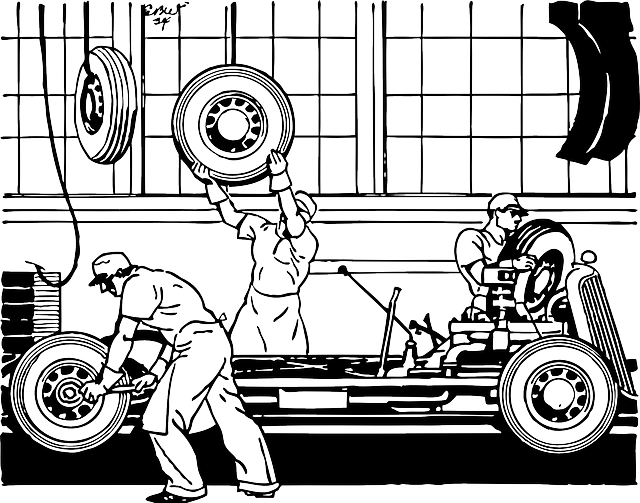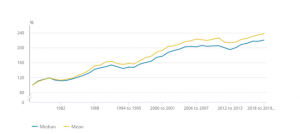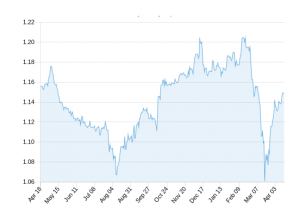THE UNITED KINGDOM AUTOMOBILE INDUSTRY ASSIGNMENT 2020
Abstract
The United Kingdom automobile industry is found to be largely impacted by the external environmental factors. The political factors relating to Brexit followed by economic stability, growth and employment rate are identified to be major factors of influence. In addition to that the disposable income of the UK population segment along with the usage propensity of private cars is a suitable mode of transportation that is identified to be of immense significance. Furthermore, the industry is found to be highly competitive due to the presence of a large number of brands operating in the country. However, the primary concern identified in this regard is the significant increase in total amount of carbon dioxide emissions from the vehicles.
The automobile industry of the United Kingdom has been identified as the primary backbone contributing to the development of a prospective economic growth. The industry is found to contribute near about £202 billion along with an employment opportunity of 800,000. The operational scope of the industry is huge and thereby severely affected by the external environmental factors including the degree of competition existing in the marketplace. The following report has analysed the external business and competitive operational environment of the UK Automobile Industry using PESTEL and Porter’s Five Forces Model respectively. Furthermore, the relative importance of considering Corporate Social Responsibility (CSR) by the sector is also discussed.
2. External Environment Analysis of UK Automobile Industry: PESTEL
The PESTEL analysis tool helps in the process of gaining data relating to external business environment using the five factors, political, economic, social, technological, environmental and legal (Rastogiand Trivedi, 2016).
The political environment of the UK is severely affected by Brexit with severe consequences on the operational activity of the automobile industry. The decision is looks forward to result in incurring additional taxes by the European countries for the purpose of exporting cars and importing necessary parts and accessories required in the process (Kolios and Read, 2013). Therefore, the automobile manufacturers will be subjected to severe decline in their relative profit margin as the total cost of production will go ahead in experiencing a steep rise followed by shareholders losing their fortune out of the investments made in the process.
The economic environment of automotive industry is found to be severely affected by change in currency exchange rates and interest rates along with other notable factors (Bateman et al., 2013). The disposable income of the UK population is identified as one of the major factors underlying the massive expansion of the industry countrywide. The financial year 2019 witnessed an increase in median income of UK population by 1.4% from £29,000 to £29,400 as shown in the following figure (Office for National Logistics, 2019).
Figure 1: Mean Annual Household Income
(Source: Office for National Logistics, 2019)
The increase in disposable income of country’s population is a clear indication of the fact that the acceptable price for purchasing a car is likely to experience a significant boost. Each of these factors are integral to the process of causing severe impact on the pricing strategy to be followed by the automotive manufacturers based on the demand existing in the marketplace. Furthermore, the currency exchange rate is found to experience a continuous drop thereby resulting in decreasing the purchase power of GBP by a large amount as shown in the following figure. The final outcome of the currency rate drop is looked forward to forcing British automotive pay a lumpsum amount of money for the purpose of importing car parts from other European nations.
Figure 2: British Pound Sterling (GBP) to Euro (EUR)
(Source: Exchange Rates UK, 2020)
The country is found to experience a rapid increase in the number of labour forces and thereby go ahead in influencing the quality and quantity of workers available for the purpose of accomplishing manufacturing operations. The employers tend to enjoy an increased choice relating to selection of suitable employee for getting their work done. The country is found to experience an employment rate of 76.5% in the year 2019 as shown in following figure.
Figure 3: Employment in the UK
(Source: Trading Economics, 2020)
The geographical diversity of the country is found to result in highlighting the differences in customer demand. The population of London, one of the most highly urbanised cities of the UK is found to exhibit less use of private cars as a means of transportation. However, Scotland, a sparsely populated area exhibits increased use of private car for the purpose of transportation due to lack of adequate public transport availability. However, the automobile industry tends to enjoy adequate degree of potential in the country.
Electric vehicles are found to gain rapid prominence in the marketplace along with smart connected vehicles too. As a result of which, high degree of research and development is required for the purpose of ensuring that the automobile manufacturers are able to adapt to the change in market trend. A wide range of collaboration with some of the notable groups like TATA, Land Rover and WMG are found to take place for the purpose of facilitating the development scope of sustainable and smart cars in the marketplace to deal with the environmental issues (Luthra, Gargand Haleem, 2015).
The environmental factor accounts for problems relating to regulation of CO2 emission in the air and the pollution caused by the vehicles. As a result, of increased environmental issues, the country is found to go ahead in adoption of strict rules and regulations. It has resulted in automobile manufacturers like Jaguar Land Rover to come up with low-emission vehicles for customers so that no further environment degradation takes place (Brand, Tranand Anable, 2012). For the purpose of effectively surviving in this environment, automotive manufacturers are largely required to adhere themselves to environmental problems.
The increase in environment regulation impact on the automotive manufacturer is likely to make the future prospect of the industry somewhat uncertain. It is due to the fact that environmental laws are looking forward to reducing the degree of carbon emission from the vehicles by 15% in the end of 2025 followed by 30% till the year 2030 (Sierzchula et al., 2012). However, such pollution reduction effectiveness is very difficult to accomplish for every manufacturer, except a few like Jaguar and Volvo.
3. Competitive Environment Analysis of UK Automotive Industry: Porter’s Five Forces Analysis
The degree of competitive forces existing in the marketplace can be largely determined with the use of Porter’s Five Forces Framework (Dobbs, 2014). It goes ahead with highlighting the factors to be considered for the purpose of enjoying long-term growth and profit potential followed by identifying the relative attractiveness existing in the industry.
3.1 Threat of New Entrants: LOW
The threat of new entrants in the marketplace is low since the process requires high capital investment and use of innovative technologies. The threshold of operating in the automobile industry is found to be very high. A large number of investors are found to intervene the automotive industry without gaining much knowledge on the technologies and business strategies required for the purpose of surviving the industrial forces.
3.2 Bargaining Power of Buyers: MEDIUM-LOW
The customers are found to enjoy a medium to low bargaining power since they are not concentrated buyers. They do not go ahead with buying cars in large quantities. This seems to lower the bargaining power of the customers largely and hence the switching cost is also identified to be low in this regard. However, due to the presence of a large number of brands to choose form, customers also go ahead with experiencing little amount of bargaining power in case of automobile industry too.
3.3 Competitive Forces Created by Rivalry: HIGH
A large number of organisations are found to operate in the UK automotive industry, comprising of both domestic players like Rolls Royce and Aston Martin along with foreign ones like BMW, Ford, Jaguar, Volvo and others. The industry is presently operating in the stage of maturity as a result of which competition is found to be severe. The foreign automotive manufacturers are found to enjoy a prominent position with the domestic players being exposed to a very limited amount of market share (Attias and Mira-Bonnardel, 2017).
3.4 Bargaining Power of Suppliers: MEDIUM-LOW
The bargaining power of suppliers in automotive industry is found to be not that much high as a large amount of spare parts such as electronic components and tyres are often required. The presence of a large number of suppliers in this case results in lowering the switching cost significantly. In this case, organisations like BMW enjoying a prominent brand position tends to enjoy high degree of operational effectiveness.
3.5 Threat of Substitutes: HIGH
The automobile industry is exposed to high threats from substitute products identified as entities that go ahead with operating the same set of function as that of a vehicle but in a different manner. One of the notable alternatives identified in this context is customers going ahead with the use of public transportation services more rather than use of private cars (Cohen, Glachant and Söderberg, 2017). The issues relating to car insurance and parking difficulty also contribute to the consideration of substitute products in automobile industry.
4. Importance of Corporate Social Responsibility (CSR) in UK Automotive Industry
Corporate Social Responsibility (CSR) highlights certain factors that an organisation operating in the automotive industry requires consideration in relation to abiding by social and environmental issues prevailing in the present society. The organisations are required to undertake business operations that far exceed their profit earning capability and sales revenue generation.
The economic responsibilities look forward to ensuring that the automotive manufacturers must develop a vehicle that is largely able to satisfy their sales generation needs and at the same time offers adequate degree of satisfaction to the shareholders too. The process needs to be planned effectively by organisations, so it does not go ahead in causing any form of negative repercussions (Loureiro, Sardinha and Reijnders, 2012). Furthermore, the automobile manufacturers also need to ensure that they are successful in satisfying their customers too.
The automotive manufacturers must pay taxes to the government so as to ensure that the political stakeholders of the organisation are able to accomplish the activities relating to effective operations of the industry (Aggarwal and Kadyan, 2014). An organisation refraining itself from paying taxes in this regard is looked forward to evading itself from its responsibility towards the society. The final outcome of such process results in developing a relationship of mistrust with the communities it tends to serve.
Ethical duty accounts for organisations operating in the automotive manufacturers to ensure that their operational activities are directly related to doing good for the society and the environment. It is of immense significance to provide the employees with better working conditions and a suitable compensation that in turn help them in the process of leading a good lifestyle. The process also accounts for adopting business practices that are largely dedicated towards the reduction of carbon dioxide in the air (Loureiro, Sardinha and Reijnders, 2012).
4.4 Philanthropic Responsibilities
The automotive manufacturers are required to develop business practices that goes ahead with developing welfare programs for the underprivileged section of the society. The organisations are found to go ahead in encouraging students to pursue education through the process of developing learning opportunities for the poor and underdeveloped sections of the society. An organisation engaged in activities relating to social welfare are often found to experience comparatively lesser chances of facing the repercussions associated with operational risks widely prevalent within the society.
The present business environment of automotive industry in the UK is found to be highly competitive with the presence of tremendous pressure from a large number of players both domestic and international. The operational factors relating to technological advancement and sustainability are identified to be notable in terms of developing a prominent position in the marketplace. However, it is to be noted that the industry tends to enjoy adequate degree of attractiveness due to the limited economies of scale. The environment is identified to be one of the primary concerns that the manufacturers needs to take into consideration in terms of enjoying adequate degree of market effectiveness.
Aggarwal, P. and Kadyan, A., 2014. Greenwashing: The darker side of CSR. Indian Journal of Applied Research, 4(3), pp.61-66.
Attias, D. and Mira-Bonnardel, S., 2017. Extending the Scope of Partnerships in the Automotive Industry Between Competition and Cooperation. In The Automobile Revolution (pp. 69-85). Springer, Cham.
Bateman, I.J., Harwood, A.R., Mace, G.M., Watson, R.T., Abson, D.J., Andrews, B., Binner, A., Crowe, A., Day, B.H., Dugdale, S. and Fezzi, C., 2013. Bringing ecosystem services into economic decision-making: land use in the United Kingdom. science, 341(6141), pp.45-50.
Brand, C., Tran, M. and Anable, J., 2012. The UK transport carbon model: An integrated life cycle approach to explore low carbon futures. Energy Policy, 41, pp.107-124.
Cohen, F., Glachant, M. and Söderberg, M., 2017. Consumer myopia, imperfect competition and the energy efficiency gap: Evidence from the UK refrigerator market. European Economic Review, 93, pp.1-23.
Dobbs, M.E., 2014. Guidelines for applying Porter’s five forces framework: a set of industry analysis templates. Competitiveness Review.
Exchange Rates UK, 2020. British Pound (GBP) to Euro (EUR) exchange rate history. [online] Available at: <https://www.exchangerates.org.uk/GBP-EUR-exchange-rate-history.html> [Accessed 17 April 2020].
Kolios, A. and Read, G., 2013. A political, economic, social, technology, legal and environmental (PESTLE) approach for risk identification of the tidal industry in the United Kingdom. Energies, 6(10), pp.5023-5045.
Loureiro, S.M., Sardinha, I.M.D. and Reijnders, L., 2012. The effect of corporate social responsibility on consumer satisfaction and perceived value: the case of the automobile industry sector in Portugal. Journal of cleaner production, 37, pp.172-178.
Luthra, S., Garg, D. and Haleem, A., 2015. Critical success factors of green supply chain management for achieving sustainability in Indian automobile industry. Production Planning & Control, 26(5), pp.339-362.
Office for National Logistics, 2019. Average household income, UK: Financial year ending 2019 (provisional). [online] Available at: <https://www.ons.gov.uk/peoplepopulationandcommunity/personalandhouseholdfinances/incomeandwealth/bulletins/householddisposableincomeandinequality/financialyearending2019provisional> [Accessed 17 April 2020].
Rastogi, N.I.T.A.N.K. and Trivedi, M.K., 2016. PESTLE technique–a tool to identify external risks in construction projects. International Research Journal of Engineering and Technology (IRJET), 3(1), pp.384-388.
Sierzchula, W., Bakker, S., Maat, K. and Van Wee, B., 2012. Technological diversity of emerging eco-innovations: a case study of the automobile industry. Journal of Cleaner Production, 37, pp.211-220.
Trading Economics, 2020. United Kingdom Employment Rate. [online] Available at: <https://tradingeconomics.com/united-kingdom/employment-rate> [Accessed 17 April 2020].





